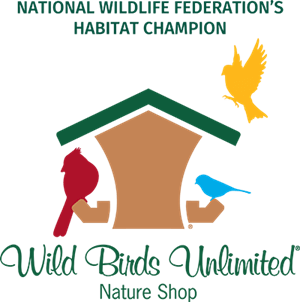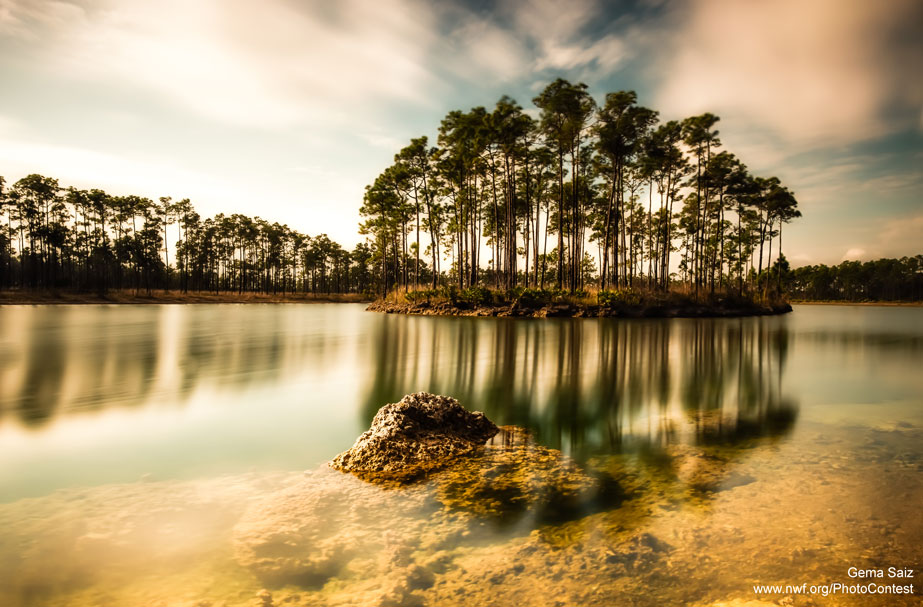We have much more to do and your continued support is needed now more than ever.
Six Ways to Support Wild Birds at Home

Birds need our help. Since 1970, the North American bird population has lost almost 3 billion breeding adults, a loss of 29 percent over just fifty years.
Habitat loss is one of the biggest reasons for the decline. Over the last five decades, the woodlands, grasslands, and coastal habitats that birds rely on have rapidly been converted into housing developments, industrial agriculture, and strip malls. Birds have lost nesting places and insect populations that birds rely on for food have begun disappearing as well. The native plant communities that supported birds are now lawns and asphalt.
The good news is that we can restore habitat for many bird species in our cities, towns and neighborhoods—starting in right in our own yards and gardens.
The National Wildlife Federation has teamed up with Wild Birds Unlimited Nature Shops—our new Certified Wildlife Habitat Champion—to encourage everyone to create a bird-friendly garden and certify it in our Garden for Wildlife program.

Six Ways to Help Wild Birds
Here are six tips from the experts at Wild Birds Unlimited on how to restore the essential elements of habitat for birds right at home. By following these tips not only will you be providing a critical habitat for birds, your yard or garden will be eligible for Certified Wildlife Habitat status.
1. Provide Food for Wild Birds
From Matt Kosty, owner of the WBU in Fayetteville, NY.
Reliable and sustainable food sources are vital to any habitat. In our habitat, we provide several types of food sources, both natural and supplemental, to benefit and attract the widest variety of backyard birds.
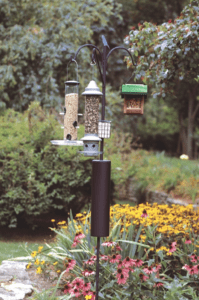
Provide native plants in your habitat to attract more backyard birds. Native plants provide the best natural sources of food such as nectar, pollen, fruit, berries nuts and seeds. These plants all attract insects, which are vital to the habitat and provide another high protein food source for backyard birds.
In addition to native plants, you can offer supplemental food sources. Examples of supplemental food sources are high quality, high-fat seed, nectar, suet, tree nuts and nyger. Supplemental food sources are attractive to birds because they provide a reliable food source year-round. By maintaining a habitat that contains both natural and supplemental food, you will attract, maintain and benefit more backyard birds in your habitat.
2. Provide Water
From Julie and Mark Hanson, co-owners of the WBU in Santa Monica, CA.
Here in Southern California, all you have to do is look at the local news to know how important a local water source is for birds. Our on-again, off-again droughts—this year drought appears to be on—make for uncertain water sources for birds, who, after all, need drink and/or bathe every day. Even without a drought, there are few natural water sources in dry Southern California.
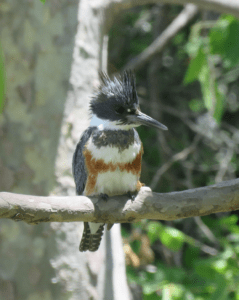
Our customers are aware of the need for reliable water in a bird-friendly habitat and have come up with creative solutions that, not only help birds, but also beautify their yards.
One customer used just a painted galvanized laundry tub and added flat rocks in and around the tub to create different depths. A tiny pump gives the water motion, and the birds love it.
Still other customers have let their creativity flow for their bird habitats with water. One built a sort of bird paradise in his backyard with a multilevel waterfall, small trees and bushes, and bird feeders everywhere. His efforts brought in, among many other birds, a belted kingfisher, the only one reported locally in a back yard.
The reward for adding water to your habitat: birds and more birds. The customer who put out the galvanized tub found he got flocks, even before his feeders were up.
3. Provide Cover for Birds
From Amy Legg and Kellie Watts, co-owners of the WBU in Lake Forest Park, WA, along with Daphne Legg, store manager.

Cover is the birds’ habitat and is required to help them hide from predators and safely introduce their fledglings into nature. In order to have birds in our yards and have the opportunity to watch them, we have to provide adequate cover for them.
Native plants are especially important because they can thrive in nature, according to the area in which they are native, with minimal care. This ensures that the birds have a consistent amount of cover and habitat in which to thrive.
Because the plants are native, insects of each particular region are naturally attracted to those plants at the appropriate times, providing a food source for birds.
Natives also easily transition through the different seasons and weather changes of each area appropriately. For example, when we have a very wet time in Seattle, because the plants are native to that area, they are able to adjust to the soggy weather and remain healthy. In the same manner, during a dry time, native plants are able to adapt and remain healthy because they are built to withstand the weather that’s happening in each area.
As the native plants transition through each season, they also produce the needed elements for birds at the right times: producing food at the right times (through insects attracted or berries produced) and blooms at the times for appropriate pollination.
In short, the native plants we offer in our store provides the perfect cover and consistency for our area, even as the weather changes and the seasons change. These plants stay healthy when other non-native plants that Daphne calls “prima donnas” may die or wither, impacting the birds’ cover and habitat.
4. Provide Place to Raise Young
From Brian Neiman, owner of the WBU in Lisle, IL.
While most people think of places to raise young as it relates to getting their yard certified as wildlife habitat as the simple installation of a birdhouse, the idea is bigger than that.
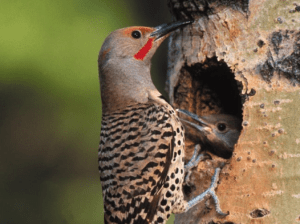
First of all, not all birds will make use of a birdhouse. Yes, there are a variety of cavity-nesting birds from House Wrens to Screech Owls that will use a birdhouse, but to attract the widest variety of birds to your property one needs to think in the broader context of habitat.
But what do you do specifically to create bird-friendly habitat? Start and leave a brush pile, a refuge for birds to nest and to escape brutal weather swings. Leave a tree snag for cavity-nesting birds to excavate and nest. Let that mud spot alone where grass will not grow, so birds can utilize the mud to make their nest. Convert some lawn to native hedgerow, which will support a vast array of nesting birds. Yes, putting up a birdhouse is the easy way out to make the certification grade, but as noble as that is, one’s opportunity to positively impact the diversity of birds on their property is indeed limitless.
5. Sustainable Practice: Arborist Woodchips
From Pam and Bob Gors, co-owners of the WBU in Macomb, MI.
If you have any bare areas in your landscape not covered by plants, mulch can be an important factor in sustainable practices because it suppresses weeds, moderates the temperature of the soil, and retains moisture – ultimately creating a healthier garden soil.
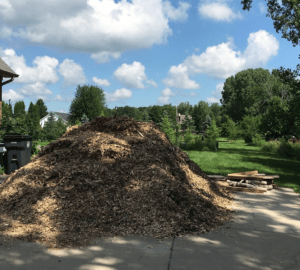
Arborist chips are made up of bark, wood and often leaves of the trees being removed by tree services. Because they are a byproduct of a tree trimming service, they are often free to anyone who requests them. Because of their diverse composition, they don’t compact into impenetrable mats as common bark mulches do, which may discourage moisture from flowing through them into the soil below. There are many misconceptions about arborist mulch. No, the disease of the tree being cut down will not infect your trees. The chips will not tie up the nitrogen in your soil nor will it change the pH of your soil.
Arborist chips spread on top of your soil will save you hours of weeding, reduce your water bill, and feed your soil. As the wood chips deteriorate, bugs in all stages (eggs, larva, adult) will take up residence, serving as a grocery store for birds. Just be prepared when you call for a load, you may get more than you bargained for and need to make other arrangements on where to park your car.
6. Get More Expert Advice
Visit your local Wild Birds Unlimited store for more expert tips on how you can support bird populations locally and how to achieve Certified Wildlife Habitat status for your yard or garden.
